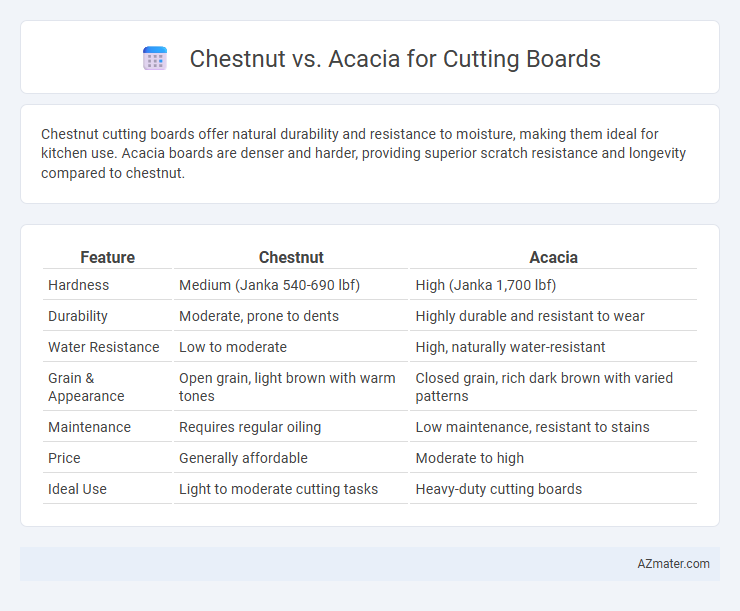Chestnut cutting boards offer natural durability and resistance to moisture, making them ideal for kitchen use. Acacia boards are denser and harder, providing superior scratch resistance and longevity compared to chestnut.
Table of Comparison
| Feature | Chestnut | Acacia |
|---|---|---|
| Hardness | Medium (Janka 540-690 lbf) | High (Janka 1,700 lbf) |
| Durability | Moderate, prone to dents | Highly durable and resistant to wear |
| Water Resistance | Low to moderate | High, naturally water-resistant |
| Grain & Appearance | Open grain, light brown with warm tones | Closed grain, rich dark brown with varied patterns |
| Maintenance | Requires regular oiling | Low maintenance, resistant to stains |
| Price | Generally affordable | Moderate to high |
| Ideal Use | Light to moderate cutting tasks | Heavy-duty cutting boards |
Introduction to Chestnut and Acacia Wood
Chestnut wood is prized for its light color, fine grain, and natural resistance to decay, making it an excellent choice for cutting boards that combine durability with aesthetics. Acacia wood, valued for its rich, dark hues and dense, heavy grain, offers superior hardness and water resistance, ideal for tackling tougher kitchen tasks. Both woods provide distinct advantages, with chestnut leaning towards a softer, more sustainable option, while acacia delivers a robust, long-lasting surface for cutting and chopping.
Wood Hardness and Durability Comparison
Chestnut wood features a Janka hardness of approximately 540, making it moderately soft and less resistant to deep scratches and dents compared to acacia, which has a Janka hardness around 1750. This significant difference in hardness means acacia cutting boards offer superior durability and longevity, maintaining a smooth surface despite frequent knife use. Acacia's dense grain structure also enhances its resistance to moisture and warping, making it an ideal choice for more durable and long-lasting cutting boards.
Grain Patterns and Aesthetic Appeal
Chestnut cutting boards feature a warm, reddish-brown hue with subtle, straight grain patterns that provide a classic and uniform aesthetic ideal for traditional kitchens. Acacia cutting boards exhibit a rich, varied coloration ranging from golden brown to deep amber, with distinctive swirling and interlocking grain patterns that create a visually striking and unique appearance. The fine, tight grain of chestnut offers a smooth texture, while acacia's varied grain enhances the board's natural beauty and adds character to any culinary space.
Water Resistance and Maintenance Needs
Chestnut cutting boards offer moderate water resistance but require regular oiling to prevent cracking and warping, making maintenance crucial to prolong their lifespan. Acacia cutting boards boast superior water resistance due to their dense, tight grain structure, reducing water absorption and minimizing bacterial growth while demanding less frequent oiling. Choosing acacia over chestnut for a cutting board ensures enhanced durability and lower maintenance efforts in wet kitchen environments.
Knife Friendliness and Surface Performance
Chestnut cutting boards offer excellent knife friendliness due to their moderate hardness, which helps preserve blade sharpness while providing a resilient surface. Acacia boards, being denser and harder, deliver superior surface durability but can cause faster blade dulling due to their rigidity. Both woods exhibit natural antibacterial properties, but chestnut tends to absorb less moisture, reducing warping and maintaining a smoother cutting surface over time.
Sustainability and Environmental Impact
Chestnut cutting boards offer a renewable and biodegradable option due to the fast growth rate and abundant availability of chestnut trees, reducing deforestation pressure. Acacia wood, while durable and dense, often comes from slower-growing trees, which may contribute to higher environmental impact if not sourced sustainably. Choosing chestnut sourced from certified sustainable forests minimizes ecological footprint through carbon sequestration and reduced habitat disruption compared to some acacia harvesting practices.
Price and Availability Differences
Chestnut cutting boards typically cost more due to their dense grain and durability, while acacia boards are more affordable and widely accessible. Acacia wood is commonly sourced from fast-growing trees, making it easier to supply and often available at a lower price point. Chestnut boards may be less prevalent in the market, reflecting their limited availability and higher price range among hardwood cutting boards.
Food Safety and Toxicity Concerns
Chestnut cutting boards are prized for their natural resistance to bacteria due to their dense grain and low porosity, making them a safe option for food preparation. Acacia wood, while durable and moisture-resistant, contains natural oils that may cause mild allergic reactions in sensitive individuals, raising minor toxicity concerns. Both woods require proper sealing and regular maintenance to minimize bacterial growth and ensure long-term food safety.
User Experiences and Popularity
Chestnut cutting boards are praised for their durability and fine grain, offering a smooth surface that resists knife marks, making them popular among home cooks who value aesthetic appeal and longevity. Acacia boards, favored for their rich color variations and natural oils, provide a sturdy, water-resistant option preferred by users seeking low-maintenance and antimicrobial properties. Both woods maintain strong popularity in kitchenware markets, with user reviews highlighting chestnut's elegance and acacia's toughness as key deciding factors.
Verdict: Which Wood is Better for Cutting Boards?
Chestnut offers a softer wood with a tight grain, making it gentle on knives but less durable against deep cuts and moisture. Acacia is a hardwood known for its high density, water resistance, and durability, providing a longer-lasting cutting surface with excellent knife protection. For cutting boards, Acacia is generally the better choice due to its superior hardness, moisture resistance, and longevity.

Infographic: Chestnut vs Acacia for Cutting Board
 azmater.com
azmater.com